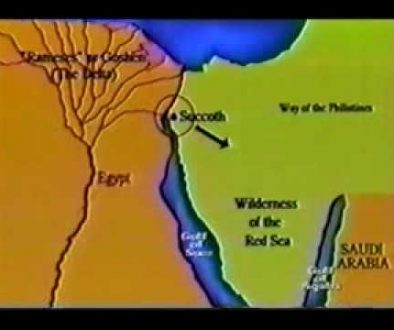Newsletter 02: January 1993
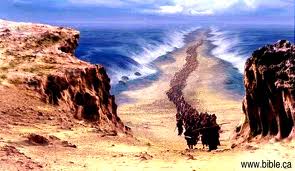 THE EXODUS: THE ROUTE OF THE EXODUS JOURNEYS
THE EXODUS: THE ROUTE OF THE EXODUS JOURNEYS
The first in-depth study we will present will be the events of the Exodus journey, beginning with the time the multitude leaves Egypt until they cross the Red Sea. A map is attached for reference. We will systematically take each step of their journey. We do not continue their journey once they cross the Red Sea and enter Midian, but we do show on the map the location of Mt. Sinai.
FIRST, LOCATE MIDIAN
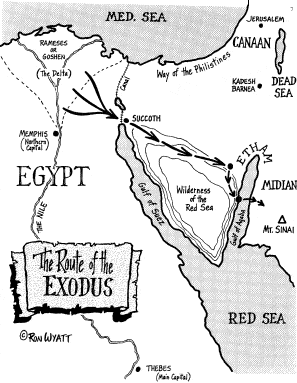 As I began to study the Biblical account, in Exodus 3, Moses encounters the burning bush while he is in Midian, tending the flock of Jethro, his father-in-law. There, God tells Moses that he is to bring forth the children of Israel out of Egypt.
As I began to study the Biblical account, in Exodus 3, Moses encounters the burning bush while he is in Midian, tending the flock of Jethro, his father-in-law. There, God tells Moses that he is to bring forth the children of Israel out of Egypt.
- “And he said, Certainly I will be with thee; and this shall be a token unto thee, that I have sent thee: When thou hast brought forth the people out of Egypt, ye shall serve God upon this mountain.”
Exodus 3:12
Moses was told in this verse to bring them back to Midian, to the mountain where God spoke to him. In my studies of ancient Egyptian history, it became clear to me that Midian was not in the Sinai peninsula — that it was in northwestern Saudi Arabia.
- “For this Agar is mount Sinai in Arabia, and answereth to Jerusalem which now is, and is in bondage with her children.”
Galatians 4:25
All through the Sinai peninsula there is tremendous evidence of the ancient Egyptians having control of this area. The inscriptions tell of their mining operations there. There are temples out there as well as fortresses. Had Moses led the people across the Gulf of Suez, they would have still been in Egyptian-controlled territory.
But in Saudi Arabia, there is no evidence of Egyptian occupation. In fact, when I showed the archaeologist from Riyadh University the petroglyphs of cows and bulls on the golden calf altar, he was very excited — he said this ancient Egyptian style of petroglyph was found nowhere else in Saudi that he knew of. The horns of the cows and bulls were drawn in the Egyptian style which represented the gods, Hathor and Aphis.
With this established, that Mt. Sinai lies in NW Saudi Arabia, and the crossing took place across the Gulf of Aqaba, let’s begin their entire route to the sea.
WHERE WAS RAMESES?
Unlike the commonly held thought, Rameses, was not a city — it was the Delta region; the land given to Joseph’s family to live in by the pharaoh. This was called “the land of Rameses” and “the land of Goshen.” This was where the great population of the Israelites lived:
“And Joseph placed his father and his brethren, and gave them a possession in the land of Egypt, in the best of the land, in the land of Rameses, as Pharaoh had commanded.” Genesis 47:11
“And Israel dwelt in the land of Egypt, in the country of Goshen; and they had possessions therein, and grew, and multiplied exceedingly.” Genesis 47:27
Rameses could not be referring to a city for the simple reason that there just wasn’t a city in ancient Egypt large enough to hold the 2-3 million people Moses led from Egypt, much less all of their flocks and herds.
THEY WERE “IN THEIR HOMES” PRIOR TO LEAVING
Also, we know that just before the “angel of death” took the lives of all the first born of Egypt, and pharaoh told Moses to take the people and go, God tells Moses to have the Israelites cook a lamb and to place the blood of this lamb upon the doors of their houses, that the “angel of death” would pass over their house:
- “Speak ye unto all the congregation of Israel, saying, In the tenth day of this month they shall take to them every man a lamb, according to the house of their fathers, a lamb for an house: And if the household be too little for the lamb, let him and his neighbor next unto his house take it according to the number of the souls; every man according to his eating shall make your count for the lamb.”
Exodus 12:3-4THEY LEAVE EGYPT THE SAME DAY
This clearly implies that they were in their homes when this event occurred. Then, He goes on to tell them to eat unleavened bread for seven days:
- “And ye shall observe the feast of unleavened bread; for in this selfsame day have I brought your armies out of the land of Egypt: therefore shall ye observe this day in your generations by an ordinance for ever.”
Exodus 12:17
God tells Moses in this verse that on that very day (selfsame day), while they are still in their homes, He will have brought them out of Egypt. This tells us that they left Egypt before sundown the day after the angel of death visited Egypt. * Note that a “day” to the Israelites was not as we think of a day – from midnight to midnight. Instead, it was from evening to evening.
- “…from even unto even, shall ye celebrate your sabbath.”
Leviticus 23:32
“And the children of Israel journeyed from Rameses to Succoth, about six hundred thousand on foot that were men, beside children.” Exodus 12:37
In summary, when word came to the people that they were allowed to leave, just after the “angel of death” visited Egypt, they all left their homes in Rameses, or Goshen, and proceeded to leave Egypt “proper.” How was this possible — that they were able to be out of Egypt so quickly?
On the map, you can see that Egypt is extremely long, but its east/west boundaries are very narrow. They left Rameses and assembled in Succoth, which was very near, but at the same time, outside of the boundary of Egypt “proper”.
WHERE WAS SUCCOTH?
Succoth had to be a place large enough for this tremendous amount of people and flocks to assemble. Long before I ever began my overseas field work, I had studied ancient Egyptian history. I had read numerous accounts of inscriptions which spoke of a place called variably “Tharu”, T’aru” and “Takut,” which fit the description of Succoth perfectly. The following are quoted from “Life in Ancient Egypt” by Adolf Erman:
“The isthmus of Suez was of the greatest consequence also from a military point of view – it was doubtless fortified in very early times. Probably here stood the great fortress of T’aru, often spoken of as the starting-point for the expeditions into Syria,…”-p.28
“The line of fortifications which was intended to keep back these Beduins of the Delta, is met with as early as the time of the Middle Empire, and is still standing. It consisted of a wall strengthened by small towers…this formed an obstruction which the slaves who tried to escape from Egypt, and the Beduins who wanted to pasture their cattle on the fields of the Delta, found difficult to pass. At this time we also meet with a defensive work of another kind, namely a broad canal, which presumably connected the lakes of the isthmus together. At the point where a bridge crossed this canal were strong fortresses on both sides… The great fortress which defended this bridge was the fortress of T’aru’, which is so often mentioned as the starting point of the military expeditions.” – p.537
To sum up what he has said, in ancient Egypt, there was a line of guarded fortifications along the canal which connected the Gulf of Suez with the Mediterranean Sea. This canal is known to have existed anciently by satellite photos and infrared photos which still show its path. At the point where one would leave Egypt proper and go into the Sinai desert, there was a fortress and a bridge. Inscriptions tell us that this fortress was called Tharu (or one of the various spellings).
This is also located near the Delta, or “Rameses,” where the Israelites were living. “Tharu” was where the Egyptian army assembled in preparation for their military expeditions to the north. Armies consisted of a great deal of men, horses and chariots; and they required a large area to assemble properly.
Moses well knew Tharu, called “Succoth” in the Biblical account — and it was here that he organized the people for their journey. They had left Egypt proper once they crossed this line of fortification, just as the Lord had promised.
- “…and the children of Israel went up harnessed out of the land of Egypt.”
Exodus 13:18
THEY LEFT “HARNESSED”
We know of a surety that “harnessed” doesn’t mean “armed with weapons” because they had no weapons until God provided them by washing the bodies of the dead Egyptian army upon the shore after the waters of the Red Sea closed back up. The chariot soldiers had to strap their weapons to their bodies, and when they were washed upon the shore, the multitude simply collected their weaponry.
So what does it mean? The Hebrew word “chamushim,” which is the Hebrew word translated “harnessed” in the above verse, is found only 4 times in the Hebrew text — Exodus 13:18; Joshua 1:14; Joshua 4:12; and Judges 7:11. The word means “in ranks.” Apply that definition to the above texts and see for yourself if it does not seem appropriate. Also of note, is the fact that in Numbers, Deuteronomy and Joshua, the Hebrew word “chalats” is used in denoting “armed soldiers.”
If we really study the Biblical account, and use good, common sense — we can learn much from what is implied, but not actually spelled out for us. Moses, as “the son of Pharaoh’s daughter,” was the heir to the throne of Egypt. As such, he was the “crown prince.”
If you study any Egyptian history, you learn that the person in line for the throne was given very exacting training — the Pharaoh was considered the “earthly embodiment of the god”, so the “pharaoh-in-training” spent a part of his training studying with the priesthood:
- “And Moses was learned in all the wisdom of the Egyptians, and was mighty in words and in deeds.”
Acts 7:22
The next stage of a crown prince’s training was military. Moses was thoroughly trained in all aspects of military leadership and would have known well how to assemble large numbers of peoples for travel.
While no specifics are given in the Bible as to Moses’ life in Egypt, several ancient historians make reference to the fact that he was a general. And we admit that we do not accept all of what these people have to say as being totally accurate, but the fact that Moses was indeed a general in the Egyptian army seems to have been a well-known fact.
Josephus writes about this in his “Antiquities of the Jews,” Book II, Chapter X. As a military man, once again, Moses knew “Tharu”, and it was here that he organized his largest “army” ever for travel. And from here, they travelled to Etham.
WHERE WAS ETHAM?
- “And they took their journey from Succoth, and encamped in Etham, in the edge of the wilderness.”
Exodus 13:20
Etham was in the “edge of the wilderness.” What wilderness was this? The answer is in the Exodus account:
- “But God led the people about, through the way of the wilderness of the Red sea…”
Exodus 13:18
It was the Wilderness of the Red Sea — the mountainous land of the mid and southern Sinai Peninsula. This was along a route that was commonly taken in those days by both caravans and the army, and it was called “the southern route.” This route was taken because it was safer than travelling along the coast, where the Philistines were.
Etham was not a singular location, like a town – it was a designation of the land that lay around the mid-northern edge of the Gulf of Aqaba. We know this because once they cross the sea, they are still in an area called Etham:
- “And they departed from before Pihahiroth, and passed through the midst of the sea into the wilderness, and went three days’ journey in the wilderness of Etham, and pitched in Marah.”
Numbers 33:8
It was while they were at Etham on the western side of the sea that God told Moses:
- “Speak unto the children of Israel, that they turn and encamp before Pihahiroth, between Migdol and the sea, over against Baalzephon: before it shall ye encamp by the sea. For Pharaoh will say of the children of Israel, They are entangled in the land, the wilderness hath shut them in.”
Exodus 14:2-3
In order for them to be “entangled in the land,” they would have to be travelling through an area of wadis (canyons) with high mountains all around, which would seem to hem them in. This takes place prior to crossing the sea, so I looked for an area such as this which would terminate on a beach or shore of the sea which was large enough to hold perhaps 2 or 3 million people, as well as their flocks.
I found a beach of tremendous size on the Gulf of Aqaba at Nuweiba, and the only passage to it is through an 18 mile long wadi system.
From “Etham in the edge of the wilderness”, they changed their direction of travel from a northerly direction, (which would have soon taken them around the northern tip of the sea,) and went south, through a wadi system that must have appeared like an endless maze to them. Hemmed in to the left and right, they could only travel in one direction — and the only path through that wadi leads to the tremendous sized beach.
THE SITE OF THE CROSSING
 As I mentioned, I found this tremendous beach on the Gulf of Aqaba which could easily have held the multitude, their flocks, and also pharaoh’s army — separating the two groups by several miles. But there’s another interesting fact about this site…
As I mentioned, I found this tremendous beach on the Gulf of Aqaba which could easily have held the multitude, their flocks, and also pharaoh’s army — separating the two groups by several miles. But there’s another interesting fact about this site…
Josephus gives an additional bit of information in his “Antiquities of the Jews” Book II, Chapter XV. Speaking of pharaoh’s army pursuing the multitude, he states:
- “They also seized upon the passages by which they imagined the Hebrews might fly, shutting them up between the inaccessible precipices and the sea; for there was [on each side] a [ridge of] mountains that terminated at the sea, which was impassable by reason of their roughness, and obstructed their flight; wherefore they there pressed upon the Hebrews with their army, where [the ridges of] the mountains were closed with the sea…”
 When I first visited the site of Nuweiba in 1978, these mountains could be seen on the south end of the beach area which terminated at the sea — no passage would have been possible to the south. (See color photo below of this area, where the mountains meet the sea on the south end.) As I found the chariot parts when diving on the southern end of the beach, this implies that the multitude travelled to this section of the beach.
When I first visited the site of Nuweiba in 1978, these mountains could be seen on the south end of the beach area which terminated at the sea — no passage would have been possible to the south. (See color photo below of this area, where the mountains meet the sea on the south end.) As I found the chariot parts when diving on the southern end of the beach, this implies that the multitude travelled to this section of the beach.
Pharaoh’s army entered from the same wadi, which is the only entrance onto the beach. This wadi is located midway of the beach, and once the army entered the area, the multitude’s only means of escape would have been to the south. But the mountains to the south extend all the way to the sea — they had no way of escape, or so it seemed.
PIHAHIROTH, MIGDOL AND BAALZEPHON
- “Speak unto the children of Israel, that they turn and encamp before Pihahiroth, between Migdol and the sea, over against Baalzephon: before it shall ye encamp by the sea.”
Exodus 14:2
When God gave Moses these instructions, it is evident that Moses knew where these places were — he was familiar with the land.
On the north end of the beach area, there are the remains of an ancient Egyptian fortress, which would have prevented their going north when they entered the area. This fortress was another evidence that Egyptian territory extended all the way through the Sinai peninsula. (See color photo of this fortress on the northern end of the beach area.) We believe this was Pihahiroth.
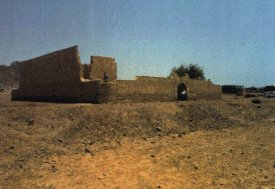
As they were in between Migdol and the sea, Migdol could either be the mountains to the west, which make a perfect barrier, enclosing them on the beach — or it may have been a watch-tower which set on top of one of those mountains. We have not climbed all those mountains and searched for one, yet. But the Egyptians did have watch-posts all through the Sinai Peninsula, and most likely would have had one here, to keep an eye on ships coming up the Gulf of Aqaba.
It is historically documented that they flashed messages from watch-tower to watch-tower using reflected sunlight by day and fire by night. In fact, that may well be how pharaoh knew exactly where Moses and the people had gone. Moses would have most certainly been aware of these watch-towers.
On the opposite shore, in Saudi Arabia, exactly across from where they entered the sea, is another ancient structure. All alone on the beach, it may have been a Midianite fortress, dedicated to Baal; we believe this was Baalzephon. The phrase “over against” seems to mean “opposite of” in respect to being across a body of water — in the next verse, the same phrase is used when speaking of being across the Jordan River from Jericho:
“Get thee up into this mountain Abarim, unto mount Nebo, which is in the land of Moab, that is over against Jericho; and behold the land of Canaan, which I give unto the children of Israel for a possession.” Deuteronomy 32:49
The fact is that chariot parts have never been found in the Red Sea anywhere except at this site. The question has been asked: “Isn’t this site for the crossing too far? Wouldn’t it have taken them a long time to get there?” Well, in 1967, Moshe Dyan marched his troops from Nuweiba (the crossing site) to Suez City (near ancient Tharu/Succoth) in six days. And they camped at night.
The Israelites were told to use only unleavened bread for seven days – indicating that they would be travelling quite briskly without time to camp for seven days.
“Seven days thou shalt eat unleavened bread, and in the seventh day shall be a feast to the LORD. And thou shalt shew thy son in that day, saying, This is done because of that which the LORD did unto me when I came forth out of Egypt.” Exodus 13: 6,8
The Israelites didn’t stop and encamp every night, as Moshe Dyan’s troops did — they travelled both day and night:
“And the LORD went before them by day in a pillar of a cloud, to lead them the way; and by night in a pillar of fire, to give them light; to go by day and night:” Exodus 13:21
With the Divine assistance of the Lord, this massive wave of people travelled in an orderly fashion both day and night, with great speed:
“Ye have seen what I did unto the Egyptians, and how I bare you on eagles’ wings, and brought you unto myself.” Exodus 19:4
The eagle is used to denote speed:
“Saul and Jonathan were lovely and pleasant in their lives, and in their death they were not divided: they were swifter than eagles, they were stronger than lions.” 2 Samuel 1:23
ONE LAST EVIDENCE
In 1978, when I first visited the beach area with my two sons, we found a Phoenician-style column lying on the southern end of the beach. Partially in the water, the inscriptions had been eroded away, or possibly they were purposefully chiselled away. We found this during the time that Israel was occupying the Sinai, and we pointed it out to the soldiers who were patrolling the beach. The next time we returned, we found they had moved it across the road and set it up in concrete.
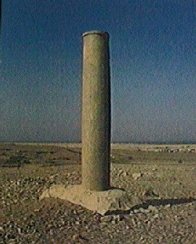
We didn’t fully understand the importance of this column until a few years later — we did recognize that it was definitely not of Egyptian style. But in 1984, when we were imprisoned in Saudi Arabia, our captors, in an effort to verify our story that we believed Mt. Sinai was there and that “Musa” (Moses) led the people across the sea to their country, had me take them to the beach where they arrived after passing through the sea. I directed them to the spot in a helicopter.
Landing here, I found another column — identical to the one on the opposite shore — except this one had the inscriptions intact. Noting carefully the Phoenician (Archaic Hebrew) letters, we were later able to have it translated. It contained the words: Mizraim (Egypt); Solomon; Edom; death; pharaoh; Moses; and Yahweh.
From this, we knew that King Solomon had erected these columns in honor of Yahweh and dedicated them to the miracle of the crossing of the sea. And, that column possibly saved my sons’ and my lives — it proved what I had been telling my Saudi jailers!
This year, we discovered that the Saudis have removed the column on their beach from its original location — they have sunk a large marker in concrete where it was located — and we are trying to locate it in their Antiquities files. But we have documented the solitary marker, sunk into the ground in concrete, on the beach, just down from the remains of the ancient fortress we believe was Baalzephon. We will study the sites on the Mt. Sinai side of the gulf later this year.
THE CONTROVERSY OVER THE “RED SEA”
There has been much controversy through the years over “which” Red Sea is being referred to in the Exodus account. You will see here, that “Red Sea” is used to refer to all section of that sea — the main body, the Gulf of Suez and the Gulf of Aqaba.
If you will get a large map of Egypt, you will note that the Red Sea is quite large — beginning at Ethiopia on the southwest and Yemen on the southeast. It separates northern Africa from Arabia. At its northern end, it splits into two arms – the Gulf of Suez and the Gulf of Aqaba.
Let’s go to the first reference to the Red Sea in the Bible — the plague of the locusts had covered all the land of Egypt. If you go the map, you will see that Egypt extended far south of the Suez arm of the Red Sea. Thebes, the ancient capital of Egypt, lay a good 150 miles south of the beginning of the Gulf of Suez (as the crow flies.) Now, these locusts were in all the “coasts” of Egypt, including Thebes and beyond.
“And the LORD turned a mighty strong west wind, which took away the locusts, and cast them into the Red sea; there remained not one locust in all the coasts of Egypt.” Exodus 10:19
A west wind, blowing the locusts into the “Red Sea”, would blow them into the main body of the sea and the Gulf of Suez. The second reference is:
“But God led the people about, through the way of the wilderness of the Red sea: and the children of Israel went up harnessed out of the land of Egypt.” Exodus 13:18
This “wilderness” was the land between the two arms of the Red Sea. Now, we will go to a scripture concerning Solomon’s navy:
“And king Solomon made a navy of ships in Eziongeber, which is beside Eloth, on the shore of the Red sea, in the land of Edom.” 1 Kings 9:26
This reference is definitively speaking of the Gulf of Aqaba, because we know where Eloth (Eilat) was. And this is the same Red Sea that Moses led the great multitude across. The Red Sea of Moses’ day was the same Red Sea we know today — the main body of the lower Red Sea, the Gulf of Suez and the Gulf of Aqaba.
Again, we can only marvel at how the Lord has preserved these sites throughout history. If the true location had been known all along, there would be no evidence left. We live in a time when people simply don’t believe the Red Sea crossing ever really happened, and God tells us that He knew that time would come:
“Therefore, behold, the days come, saith the LORD, that it shall no more be said, The LORD liveth, that brought up the children of Israel out of the land of Egypt” Jeremiah 16:14
But He does “liveth”, and before it’s all over with, He will vindicate His Word to the world.






